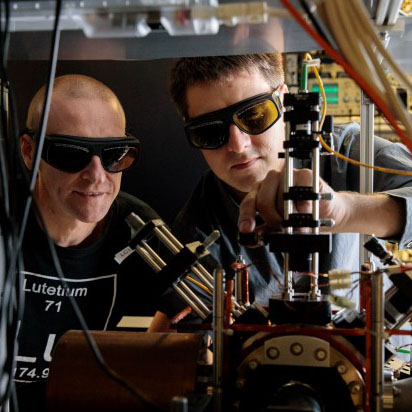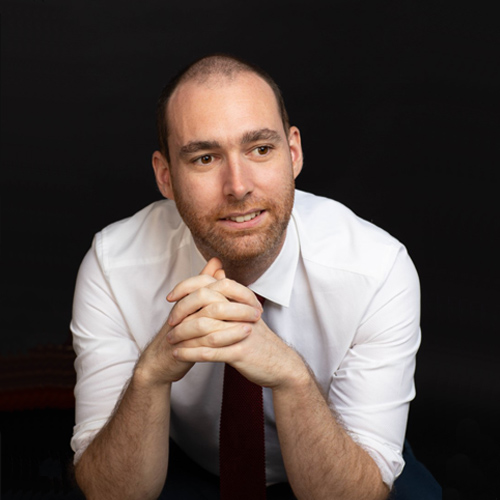Highlights
Novel superradiant laser promises to make ultrastable light sources practical
 In collaboration with a team in the US including the pioneer of superradiant lasers, CQT's Travis Nicholson (left), Yu Xianquan (right) and Steven Touzard have co-authored a proposal for a new ultrastable laser design.
In collaboration with a team in the US including the pioneer of superradiant lasers, CQT's Travis Nicholson (left), Yu Xianquan (right) and Steven Touzard have co-authored a proposal for a new ultrastable laser design.
A new design for lasers could bring top-performing devices to the masses, empowering research labs and fuelling development of precision clocks and other sensors.
That’s the hope of researchers at the Centre for Quantum Technologies at the National University of Singapore and their collaborators at JILA, a joint institute of the University of Colorado, Boulder, and the US National Institute of Standards and Technology, who propose a new approach to building stable lasers in a paper published 18 December in Physical Review Letters.
“The idea is to democratise ultrastable lasers. Right now they are only accessible to a few specialised teams. We want everyone to have them,” says Travis Nicholson, a CQT Principal Investigator and co-author on the paper. The design combines two old ideas – the phenomenon of superradiance and hot atomic beams – in an entirely new way.
According to the team’s calculations, the resulting laser would have performance competitive with the best ‘clock lasers’ available today. Since the work was presented at conferences, the team has been approached by several groups who are interested in this idea. “It’s the first time I’ve worked on a proposal that generated this much interest before it was even published”, Travis said.
In search of stability
The most stable lasers on Earth are currently used in the world’s most precise atomic clocks, where they achieve frequencies stable to 18 decimal places. However, these lasers are custom machines that require ample resources, including maintenance by a team with specialised training in laser stabilisation technology. Moreover, these lasers are not useful for field-based applications since they must be kept in carefully controlled environments. Travis, who worked with an ultrastable clock laser during his PhD, jokes that “It was a monster. And it was so sensitive that you sneeze next to it and three people have to run in to fix it.” Even off-the-shelf stable lasers with more modest performance need careful handling and cost hundreds of thousands of dollars.
A cheaper, more robust way of building stable lasers would be a boon to research labs around the world, not only to advance atomic clocks but also for tests of fundamental physics. For example, such lasers could help search for dark matter, detect gravitational waves and measure any changes in fundamental constants.
A design that works outside lab environments would also enable more applications. Better lasers could be built into satellites to improve GPS, added to spacecraft for deep-space navigation, or used to measure gravity with high precision for earth science applications such as natural disaster detection or mineral prospecting.
Good cavity, bad cavity
The essentials of a laser are a medium that emits light, which is placed inside a cavity made of two mirrors facing each other. In conventional lasers, the laser’s action – light amplification by stimulated emission of radiation – is triggered when light bouncing backwards and forwards between the two mirrors interacts with the light-emitting material. One of the mirrors allows just a little of the light to escape to emerge as the laser beam.
To stabilise the laser, its frequency can be ‘locked’ to a resonance in a second stabilisation cavity. In this configuration, the frequency noise in the laser is determined by fluctuations in the length of the stabilisation cavity. “Pretty much all of laser stabilisation to date has been figuring out crazier ways to make the cavity length more stable,” says Travis. That has included structural engineering of the mirrors and cavity spacer, environmental control, elaborate cavity mounting schemes, and using a longer cavity. The most stable lasers use cryogenically cooled silicon cavities.
In the new proposal, the laser’s stability does not depend on cavities at all. The laser’s main cavity is operated in ‘bad cavity’ mode where it traps just a little light and allows most to escape. Instead, the stability of the laser is determined by the properties of the ‘superradiant’ material inside the cavity – densely-packed atoms primed to emit narrow-linewidth light, and the critical component of the new design.
PhD student Yu Xianquan, a co-author on the paper, explains: “Intuitively, one may think a mHz linewidth laser should be super sensitive to environmental noises. However, the theories predict that the superradiant beam laser is incredibly robust because the laser's phase information is stored primarily in the atomic medium.”
Superradiance
The first superradiant laser was reported in 2012, using cold atoms inside a cavity. The small amount of light trapped in the cavity causes the atoms to collectively emit light at higher intensity than a collection of individual atoms would do.
The sophisticated tools required to prepare and control cold atoms meant this technology is not easily adopted. The design also had some drawbacks. The laser could only make pulses, not operate continuously, because the optical pumping required to excite the atoms for laser operation heated – and quickly destroyed – the cold atom sample. After each pulse, a new cold atom sample needs to be prepared.
Travis and colleagues think their design could solve all these issues in one swoop: instead of trapping cold atoms in the cavity, they suggest using a hot beam of atoms that passes through the cavity. The atoms would be pumped before they enter the cavity, emit while they are inside the cavity, and then deposit on a cold metal plate when they exit.
Compared to making cold atoms, making a hot beam is easy. A lump of the material is evaporated in a simple oven, with the hot atoms flying out of a hole in the oven. This setup would be simple and robust enough to easily be constructed by non-specialists or to run in challenging real-world environments, unlike superradiant lasers using cold atoms or ultrastable lasers using silicon cavities.
In the paper, the team present calculations for a laser using hot beams of calcium or strontium atoms, predicting they could achieve continuous output at high stability with seven or eight orders of magnitude more power than cold atom designs. With calcium, for instance, they estimate the laser could deliver 0.1mW at a linewidth of 40mHz, which is competitive with silicon-cavity-based stable lasers.
At CQT, the team working on this project was Travis, Xianquan and Research Fellow Steven Touzard. The three experimentalists collaborated with four theorists at JILA.
Travis recalls early discussions for this project with his co-author Murray Holland, who proposed the original superradiant laser. Travis and Murray were previously colleagues at JILA. “We weren't sitting there going, how do we make the world's most stable laser? We were thinking, how do we make a stable laser everyone can use?” says Travis. It has taken years of work, but he thinks they’ve got there: “What we've eventually come to is a design that appears to make superradiant lasers practical.” Next it’s time to test that in the labs.
Learn more
Related Stories
 | Neglected atom has top properties for atomic clocks May 10 2018 |
 | Meet a CQTian: Steven Touzard September 09 2020 |
Laser swap can cut cost for entangled photon production March 05 2020 |






